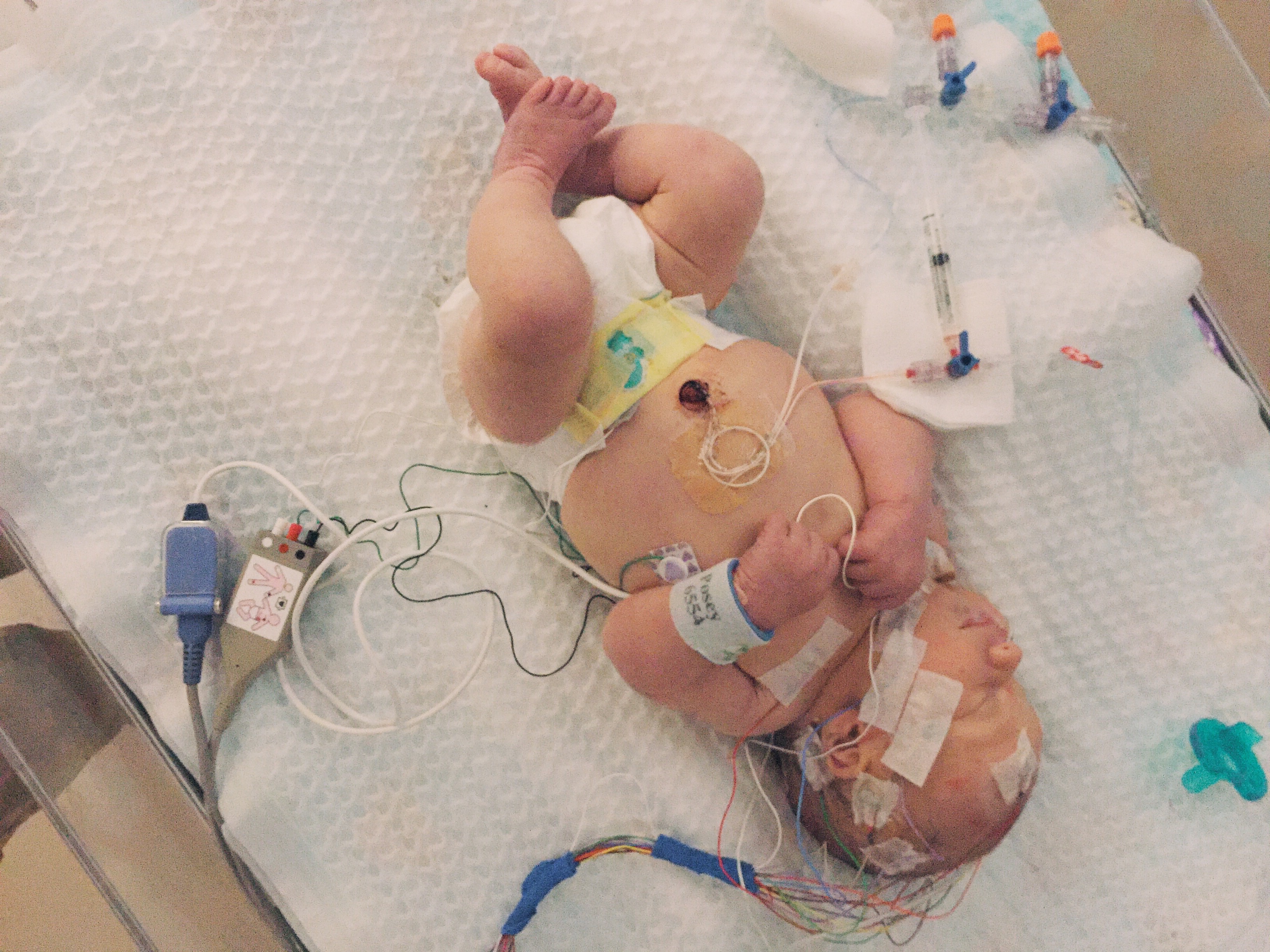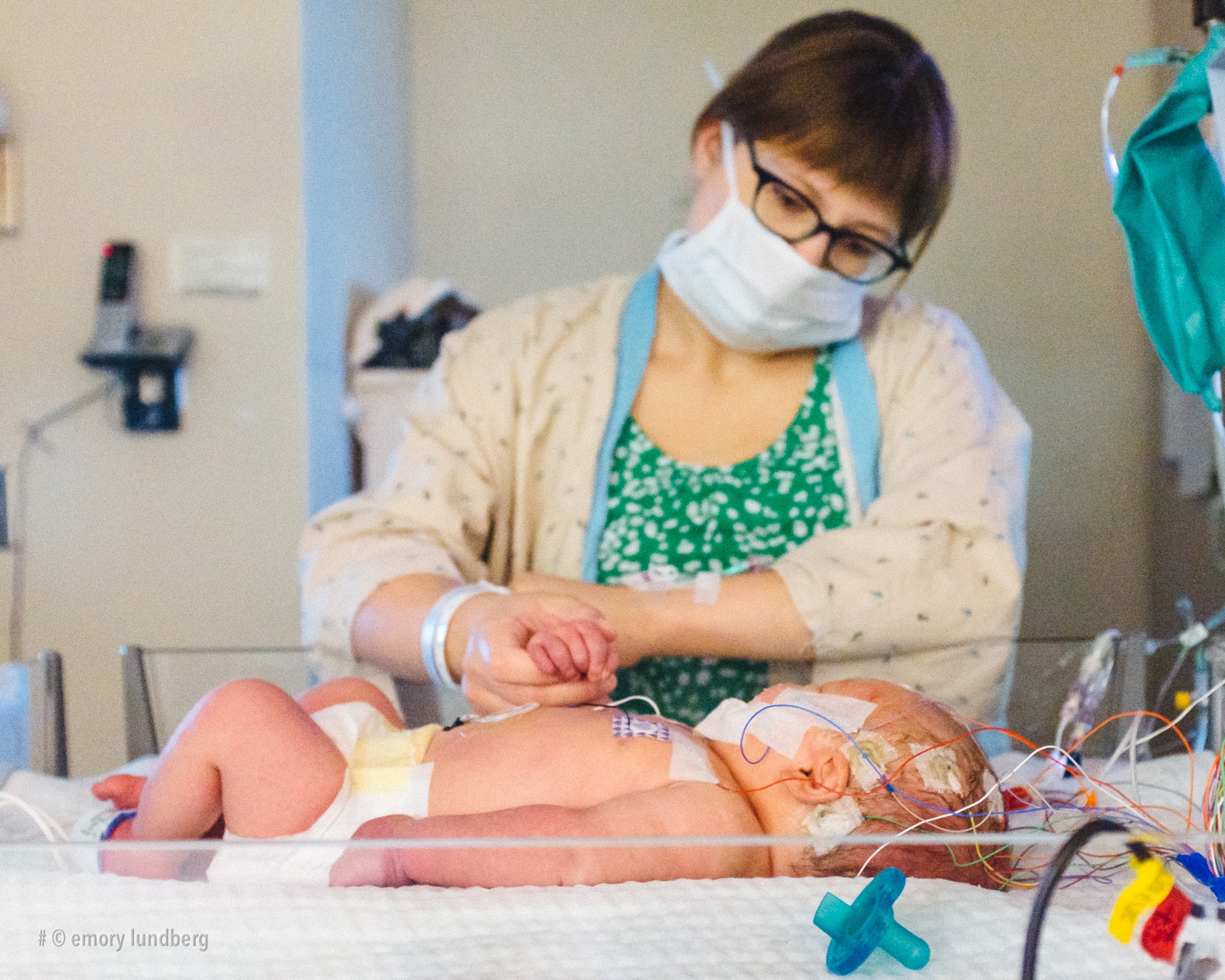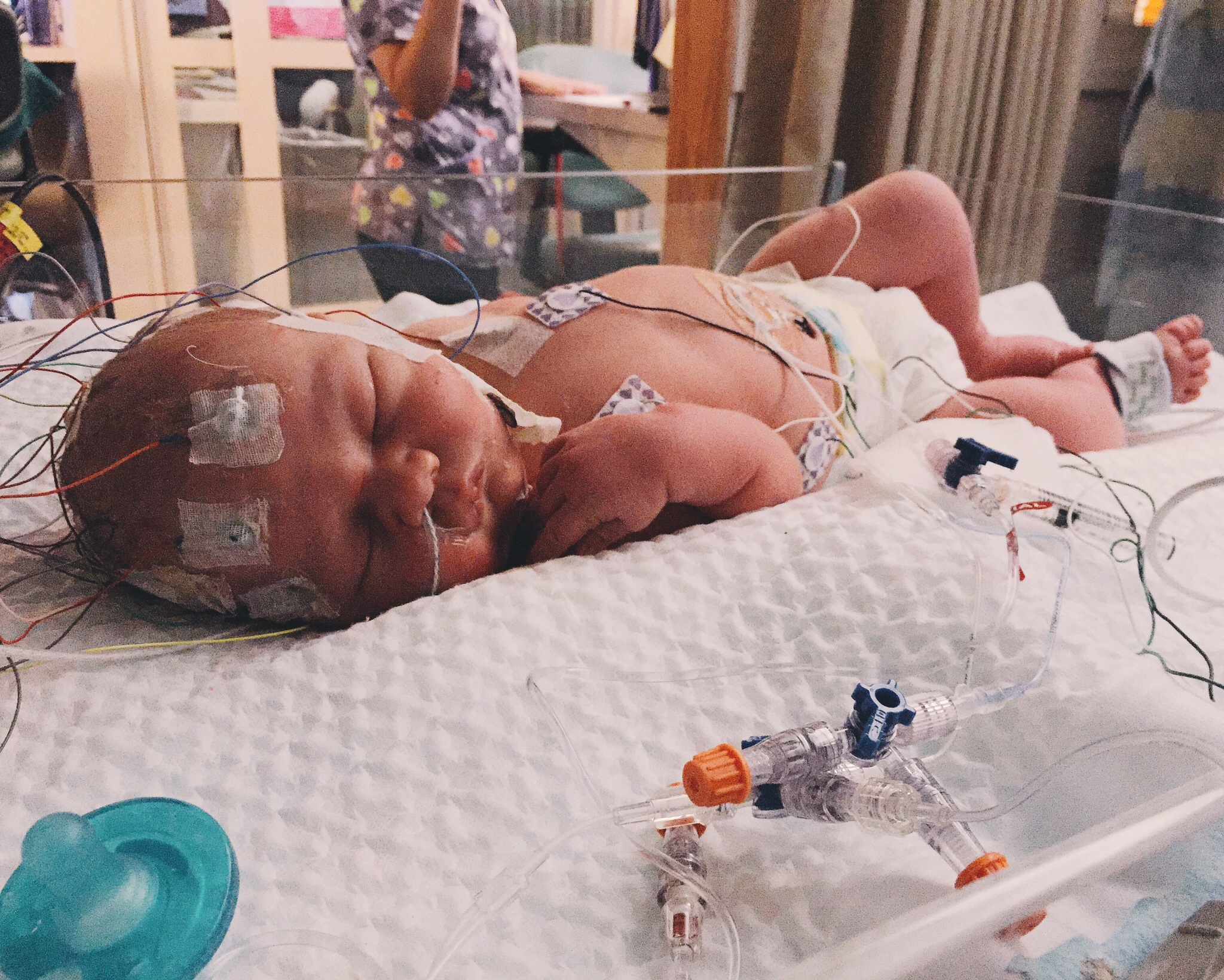Beware: Falling Serifs
This is incomplete but I wanted to get a draft out there to apply pressure on myself to have it not be incomplete. If this leaves you in a lurch, ping me on my contact form, and I'll try to help you out.
What follows is an in-progress field guide for parents that have their newborn undergoing hypothermia treatment due to an HIE or related event.
Introduction (or: WTF!?)
This is going to assume that very recently your newborn was put into the NICU, and that the medical staff are following hypothermia protocols. During birth something went wrong, and now you’ve heard a lot of terminology and met a dozen new doctors you didn’t expect to ever meet and it feels like the ground just fell out from under you and every time you are nearly back on your feet, it all goes sideways again.
I’ve been there. It’s a special kind of hell and I can’t give any medical advice or tell you everything is going to be fine; but what I can do is hold a flashlight for you and aim it at the things I had to learn about shortly after 4am on July 27, 2015. I’m not an expert or a doctor, I’ve just had to find my way in the midst of the chaos you’ve discovered for yourself.
Because I’m not a doctor a lot of what follows will be largely anecdotal and consist of my experience in a University Research Hospital in the United States. The therapy and protocols discussed in this guide have been used there for a few years and the staff all the way on down the line is familiar with it and has considerable expertise. When doing research on my own to further understand what was going on, the resources and studies I found were very difficult to wrap my head around at times, and anything I write about them here is very much a distilled and simplified version, and the inferences and conclusions I come to may well be entirely unscientific. I’m an engineer, not a scientist.
You are freaking out, and that’s OK
This whole experience is going to push your emotional boundaries and make you confront a lot of things you are afraid of. I know in the midst of it all it doesn’t matter that other people have been through similar experiences, but it helps you later. Promise.
Something Went Wrong
An HIE is hypoxic-ischemic encephalopathy, which is sometimes called Perinatal asphyxia as well (especially in older literature prior to the last decade). It is a diagnosis given when there is laboratory and clinical evidence of brain injury due to asphyxia1.
There are several ways this can occur, but ultimately this means that your baby wasn’t getting enough oxygen for a certain amount of time. There are several causes for this ranging in severity, but the result that got us here was probably resuscitation and other intervening measures to ensure your baby was able to breathe properly and get oxygen.
There are some checks and tests that doctors perform to assess the overall health of babies upon birth. They evaluate physical responses and movement, observation of color changes in skin, reactions to stimuli like bright lights and reflexive responses. Based on those observations and classifications they suspected an HIE, which probably resulted in laboratory tests that confirm their suspicions.
Those lab tests involve sampling blood from the umbilical cord and your newborn, and calculating the various deficits in the chemical composition of the blood such as the ph level, which they may often refer to as blood gases. When the ph level of the blood is abnormal, high school chemistry tells us that’s because it’s more basic or more acidic. This gives more clues for the medical team to act on.
Expertise Warning
I have no experience with Severe.
There are three-to-four severity classifications of HIE events that are commonly used. Most research I read uses three, but some prefer a more well-defined group between Mild and Moderate.
- Mild
- Mild/Moderate
- Moderate
- Severe
What they’re doing
They’re using hypothermia treatment protocols to lower the temperature of your newborn’s brain. This is the most advanced and effective treatment available to you to potentially mitigate further complications.
They are going to keep the body temperature of your newborn to around 33°C. They will probably be using a cooling mat or a cap surrounding the head.

Possible seizure activity is being monitored with an EEG, which results in a spiderweb of little wires all over the place. They correlate this activity with other collected data and observation by medical staff.
Since babies don’t like to be cold, they can get really wound up over it. Your newborn may also be intubated or require other assistance which involves more tubes and machines that also are very stressful and frustrating for babies. Because of this, they may administer a sedative to calm the baby down and this makes them sleep a lot and be a little sluggish. There will be periods of time where they get all cranky and as long as that’s when something babies get cranky about, like needing to be changed, it’s a positive sign.
You wouldn’t want a bunch of nonsense glued to your head while you sat in a wet pair of shorts either.
It’s likely that once the warming protocol begins they’ll start to figure out if the infant needs sedation anymore, or if they can administer lower doses. It takes a little while to be fully clear of it so your baby may seem a little checked out most of the time especially in hypo, so don’t let it steer you away from positive thinking. Think of it as cryo-sleep.

Why they’re doing it
Because if they don’t, horrible things will continue to happen. There are a range of conditions that can result of an HIE ranging in severity. They aren’t directly correlated to the severity of the HIE event but do somewhat correlate with the response to hypothermia treatment and how the brain reacts during the first 72 hours and the warming period of the protocols.
In cases of likely brain injury, scientists have found that inducing hypothermia within six hours of birth improves outcomes. When deprived of oxygen, the body begins looking for energy wherever it is available. It will detonate those cells and release that energy to be used elsewhere. In terms of concentration of cells and pure mass, the brains of infants are the largest source of potential energy so that’s where the the best source of this energy is, and at the same time, it’s the most dangerous place to get it.
Those cells then degrade and release cellular instructions to the surrounding cells as they die, (“they will need more energy soon, so go ahead and start blowing up!”) and this process can be halted and altered by lowering the body temperature:
“Clinical and experimental studies have demonstrated that neuronal death occurs in two phases following a reversible hypoxic-ischaemic global insult.” “Therefore, a therapeutic ’window of opportunity’ exists in the interval following resuscitation of the asphyxiated newborn before the secondary phase of impaired energy metabolism and injury.” — (Gluckman 1992; Lorek 1994; Penrice 1996)2
Essentially, they’re chilling your newborn to protect the brain and give it another start. The goal is to allow the brain to reboot and restore before the secondary degradation of cells is underway. It’s why you read about sledding or ice-fishing accidents where people are getting pulled out of the river after being trapped under ice, and miraculously recovering.

Blood tests and oxygen levels
Medical staff will regularly measure levels of the aforementioned blood gases because they’re worried about lactic alkalosis and other complications. This information helps them determine likely outcomes and interventions to do an end-run around anything on the horizon. They’re already ahead of the curve by doing the hypothermia treatment so they have a good window to fully assess likely outcomes.
NG tube
There is probably a tiny tube in the nose, to allow food and medicine to be delivered to the stomach, and to remove contents from the stomach easily. This procedure is called Nasogastric Intubation and is referred to as an NG tube.
Early on, they feed nutrients and fats via an IV and gradually start switching them to NG, even though NG is there to facilitate it later.
Breastfeeding
If you intend to breastfeed, it is a good idea to be pumping as soon as you can. The nurses in NICU can deliver your milk via the NG tube when available. Eventually you’ll be able to give it a try through less medical means. It will be amazing.
Things to start recording and tracking
Aside from the obviously New Baby Measurements of weight and length, you may want to keep a timeline of everything as best you can. This includes numerics like what the blood ph levels are, the cord blood ph, oxygen levels; and if you hear a time or number or an APGAR score, make a note of it and record the date and time you heard it. This was helpful for me to know how things were trending later, but may be meaningless for you. If you like to track metrics, these are your metrics.
If you don’t remember what they were at birth and you want that information, you can ask for it. I was furiously scribbling down everything that was said after Calvin was resuscitated. As the ph normalized throughout hypo, I found those digits reassuring.
What to expect for 72 hours
Could be busy, could be quiet. The less seizure activity recorded and observed the better. Stay in touch with the NICU and they’ll keep you apprised of the situation and anything they overheard or were instructed by the doctors.
If you have questions about any of it, make a note of them and try to catch the teams on rounds in the morning, and you’ll get looped in on the specifics as much as you want.
In our case, Calvin had one brief moment that may have been a seizure, but it wasn’t sustained and lasted seconds rather than minutes. The more severe this activity is, the more complicated the prognosis will be.
NICU
The NICU is where you’ll likely camp out and/or treat as the center of your universe for the time being.
The Nurses
The NICU nurses are your most important ally. They love babies and they apparently don’t mind crazy parents that can’t sleep. Speaking of which, if you’re at home in bed and can’t sleep; call the NICU and ask for the nurse assigned to your newborn. They’ll tell you everything that has happened since you last called or visited.
You will hear many opinions and diagnostic data
While your baby is being observed and assessed by medical staff, doctors and nurses will make comments about responsiveness of their patient, or things that are medically interesting to them. Don’t panic over this sort of thing, but make a note of anything you want to know about later. Let them do their thing and be available to answer their questions if they have any.
Please be aware that they will be managing your expectations heavily, and if you start asking questions like “Is my baby going to be OK”, you are asking a very loaded question that they can’t answer. They want to tell you that — that is their best case scenario, after all. But they don’t know the answer to that question. Asking different questions helps and doesn’t put them in a very awkward positions; “Is my baby going to be OK?” is impossible to answer, but “Is my baby’s condition improving?” is better. I went so far as to ask “Are you optimistic” a few times knowing it was close to impossible to answer, but I was desperate for something reassuring at times.
Ask what you want to ask, but don’t be disappointed or fear the worst when you didn’t ask a question they could answer the way you had hoped.
What they said and who said it
My notes often had margins like NEURO for Neurologist, NEO for Neonatologist, and RN for nurses.
It helps to sort out each team in your notes because they’re all on the same team but have different focus and what one finds interesting another may find mundane. This was another thing very helpful for me to have access to in subsequent discussions with other groups, especially when they may not be on the same page. I couldn’t keep track of all the names, and I’ll confess that I have some notes attributed to Dr. Jolly who was a very friendly and kind-hearted Neonatologist; and I also may have had others attributed to Dr. Doom, the Neurologist.
Questions to ask doctors
You can ask anything you want but do remember that they’ll be managing your expectations. I read a lot into non-verbal cues because of that. I asked if the treatment was working as intended and if they were still following the proposed protocol for hypothermia. Later I’d ask about feeding schedules and vitals and refresh my notes on the results they would tell me.
Is everything going to be OK?
Hard to imagine it could be, isn’t it? I want to remind you right off the bat that you’re doing the one thing that has the best chance of improving the long-term health and wellness of your newborn. It’s hard to discern the percentages from the studies because the specifics of each case may be different — it’s hard to imagine a situation where two births are completely identical and there are too many factors that influence the outcome in any situation, much less a complicated birth like yours.
It is also important to know that medical researchers and doctors rarely conduct tests like an MRI on routine births. I don’t know that cord blood ph is analyzed as a matter of course either unless the medical staff suspects there is an issue there, so if you go looking for raw data in medical trials and studies, be careful with comparing your situation to others if you don’t have the medical research background that can account for this sort of thing without being so close to it!
Reading through all the data I would find myself soothed one moment and in a state of panic the next. One of the trials I was reading about was halted mid-way through, and when I followed that thread for a while to find out why, the study in question was stopped because the results they were getting were so positive that they had questions about the ethics in continuing to treat newborns any other way. When reading about outcomes at 3 months, and so on, one of the columns in the chart was death. After the initial shock of this wore off I chased down that dark alley to find that in all the cases from that study where the newborn died it was due to ending life support. I can’t imagine what that would be like, and any parent that has been told their newborn has suffered a Severe HIE will need more support and guidance than I can possibly provide.
Possible Outcomes
This is the rough stuff. The likely outcomes for your newborn include a perfectly routine typical childhood and adult life with no complications due to this incident. The other outcomes include learning disabilities, cerebral palsy, mental and cognitive impairments, and other disabilities.
You should know right now that you won’t know definitively for a few years. This can easily escalate into over-analyzing every behavior or milestone. Calvin is a really laid-back kid, almost a year old at this point. He’s generally very agreeable and happy and pretty content compared to his older sister! There are times I wonder if his behavior and beginnings of his personality are symptoms or indications of something more sinister. I have to bat those distractions away or they’ll eat me alive, and it’s much more gratifying to love the little monkey and not wonder why he’s so happy to see me.
Todo:
What to do instead of totally freaking out
- Establish communications channels for family/friends/colleagues
- Maintain routines for other children in your household
- Make sure you are hydrated and resting
Get Supported
Make sure emotionally you are supported and that your obligations and perceived obligations to others are addressed
- Accept help
- Contact colleagues and friends
- Ask for stories about positive outcomes from scary births
Free your mind up for immediate things
You’ve got a lot on your plate.
What to worry about
tbd
What to not worry about
tbd
Warming
tbd
Landmarks for warming up
tbd
Neurological exams and MRI
tbd
Big grains of salt
tbd
Follow-through
tbd
-
A condition arising when the body is deprived of oxygen, causing unconsciousness or death; suffocation. ↩
-
Cooling for newborns with hypoxic ischaemic encephalopathy (Review) (PDF) ↩
